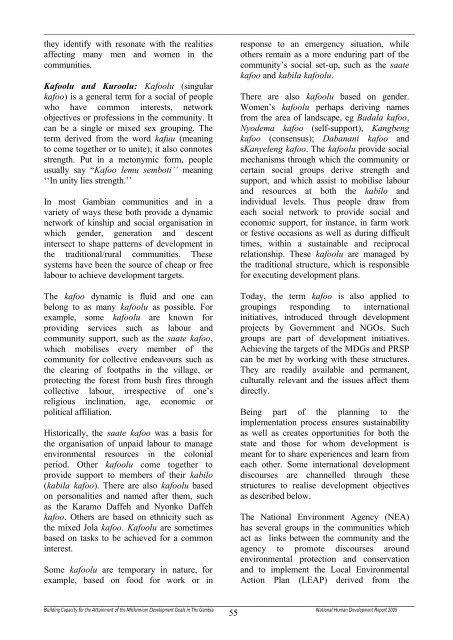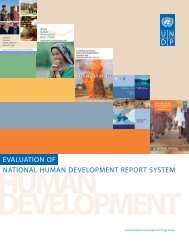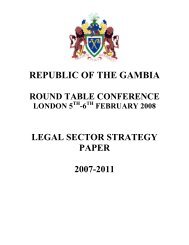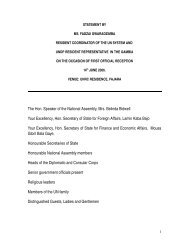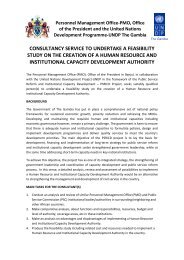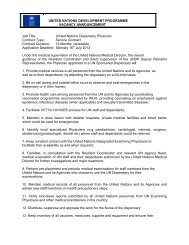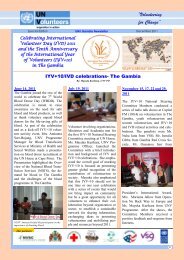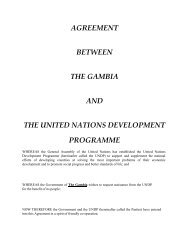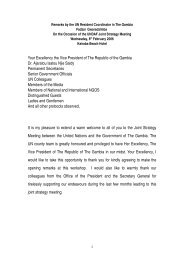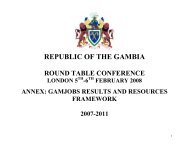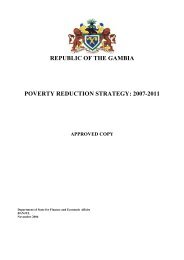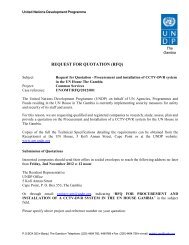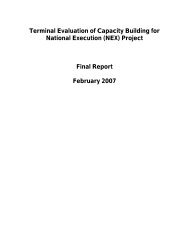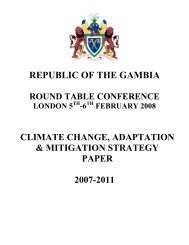Introduction - UNDP The Gambia
Introduction - UNDP The Gambia
Introduction - UNDP The Gambia
Create successful ePaper yourself
Turn your PDF publications into a flip-book with our unique Google optimized e-Paper software.
________________________________________________________________________________________________________________________<br />
they identify with resonate with the realities<br />
affecting many men and women in the<br />
communities.<br />
Kafoolu and Kuroolu: Kafoolu (singular<br />
kafoo) is a general term for a social of people<br />
who have common interests, network<br />
objectives or professions in the community. It<br />
can be a single or mixed sex grouping. <strong>The</strong><br />
term derived from the word kafuu (meaning<br />
to come together or to unite); it also connotes<br />
strength. Put in a metonymic form, people<br />
usually say “Kafoo lemu semboti’’ meaning<br />
‘‘In unity lies strength.’’<br />
In most <strong>Gambia</strong>n communities and in a<br />
variety of ways these both provide a dynamic<br />
network of kinship and social organisation in<br />
which gender, generation and descent<br />
intersect to shape patterns of development in<br />
the traditional/rural communities. <strong>The</strong>se<br />
systems have been the source of cheap or free<br />
labour to achieve development targets.<br />
response to an emergency situation, while<br />
others remain as a more enduring part of the<br />
community’s social set-up, such as the saate<br />
kafoo and kabila kafoolu.<br />
<strong>The</strong>re are also kafoolu based on gender.<br />
Women’s kafoolu perhaps deriving names<br />
from the area of landscape, eg Badala kafoo,<br />
Nyodema kafoo (self-support), Kangbeng<br />
kafoo (consensus); Dabanani kafoo and<br />
sKanyeleng kafoo. <strong>The</strong> kafoolu provide social<br />
mechanisms through which the community or<br />
certain social groups derive strength and<br />
support, and which assist to mobilise labour<br />
and resources at both the kabilo and<br />
individual levels. Thus people draw from<br />
each social network to provide social and<br />
economic support, for instance, in farm work<br />
or festive occasions as well as during difficult<br />
times, within a sustainable and reciprocal<br />
relationship. <strong>The</strong>se kafoolu are managed by<br />
the traditional structure, which is responsible<br />
for executing development plans.<br />
<strong>The</strong> kafoo dynamic is fluid and one can<br />
belong to as many kafoolu as possible. For<br />
example, some kafoolu are known for<br />
providing services such as labour and<br />
community support, such as the saate kafoo,<br />
which mobilises every member of the<br />
community for collective endeavours such as<br />
the clearing of footpaths in the village, or<br />
protecting the forest from bush fires through<br />
collective labour, irrespective of one’s<br />
religious inclination, age, economic or<br />
political affiliation.<br />
Historically, the saate kafoo was a basis for<br />
the organisation of unpaid labour to manage<br />
environmental resources in the colonial<br />
period. Other kafoolu come together to<br />
provide support to members of their kabilo<br />
(kabila kafoo). <strong>The</strong>re are also kafoolu based<br />
on personalities and named after them, such<br />
as the Karamo Daffeh and Nyonko Daffeh<br />
kafoo. Others are based on ethnicity such as<br />
the mixed Jola kafoo. Kafoolu are sometimes<br />
based on tasks to be achieved for a common<br />
interest.<br />
Some kafoolu are temporary in nature, for<br />
example, based on food for work or in<br />
Today, the term kafoo is also applied to<br />
groupings responding to international<br />
initiatives, introduced through development<br />
projects by Government and NGOs. Such<br />
groups are part of development initiatives.<br />
Achieving the targets of the MDGs and PRSP<br />
can be met by working with these structures.<br />
<strong>The</strong>y are readily available and permanent,<br />
culturally relevant and the issues affect them<br />
directly.<br />
Being part of the planning to the<br />
implementation process ensures sustainability<br />
as well as creates opportunities for both the<br />
state and those for whom development is<br />
meant for to share experiences and learn from<br />
each other. Some international development<br />
discourses are channelled through these<br />
structures to realise development objectives<br />
as described below.<br />
<strong>The</strong> National Environment Agency (NEA)<br />
has several groups in the communities which<br />
act as links between the community and the<br />
agency to promote discourses around<br />
environmental protection and conservation<br />
and to implement the Local Environmental<br />
Action Plan (LEAP) derived from the<br />
________________________________________________________________________________________________<br />
Building Capacity for the Attainment of the Millennium Development Goals in <strong>The</strong> <strong>Gambia</strong> National Human Development Report 2005<br />
55


